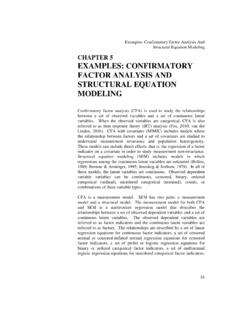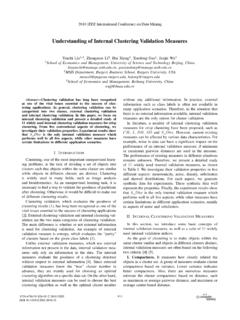Transcription of CHAPTER 12 EXAMPLES: MONTE CARLO SIMULATION …
1 Examples: MONTE CARLO SIMULATION Studies 465 CHAPTER 12 EXAMPLES: MONTE CARLO SIMULATION STUDIES MONTE CARLO SIMULATION studies are often used for methodological investigations of the performance of statistical estimators under various conditions. They can also be used to decide on the sample size needed for a study and to determine power (Muth n & Muth n, 2002). MONTE CARLO studies are sometimes referred to as SIMULATION studies. Mplus has extensive MONTE CARLO SIMULATION facilities for both data generation and data analysis.
2 Several types of data can be generated: simple random samples, clustered (multilevel) data, missing data, and data from populations that are observed (multiple groups) or unobserved (latent classes). Data generation models can include random effects, interactions between continuous latent variables, interactions between continuous latent variables and observed variables, and between categorical latent variables. Dependent variables can be continuous, censored, binary, ordered categorical (ordinal), unordered categorical (nominal), counts, or combinations of these variable types. In addition, two-part (semicontinuous) variables and time-to-event variables can be generated.
3 Independent variables can be binary or continuous. All or some of the MONTE CARLO generated data sets can be saved. The analysis model can be different from the data generation model. For example , variables can be generated as categorical and analyzed as continuous or data can be generated as a three-class model and analyzed as a two-class model. In some situations, a special external MONTE CARLO feature is needed to generate data by one model and analyze it by a different model. For example , variables can be generated using a clustered design and analyzed ignoring the clustering . Data generated outside of Mplus can also be analyzed using this special MONTE CARLO feature.
4 Other special features that can be used with MONTE CARLO SIMULATION studies include saving parameter estimates from the analysis of real data to be used as population parameter and/or coverage values for data generation in a MONTE CARLO SIMULATION study. In addition, analysis results from each replication of a MONTE CARLO SIMULATION study can be CHAPTER 12 466 saved in an external file for further investigation. CHAPTER 19 discusses the options of the MONTECARLO command. MONTE CARLO data generation can include the following special features: Single or multiple group analysis for non-mixture models Missing data Complex survey data Latent variable interactions and non-linear factor analysis using maximum likelihood Random slopes Individually-varying times of observations Linear and non-linear parameter constraints Indirect effects including specific paths Maximum likelihood estimation for all outcome types Wald chi-square test of parameter equalities Analysis with between-level categorical latent variables Multiple group data generation is specified by using the NGROUPS option of the MONTECARLO command and the MODEL
5 POPULATION-label command. Missing data generation is specified by using the PATMISS and PATPROBS options of the MONTECARLO command or the MISSING option of the MONTECARLO command in conjunction with the MODEL MISSING command. Complex survey data are generated by using the TYPE=TWOLEVEL option of the ANALYSIS command in conjunction with the NCSIZES and CSIZES options of the MONTECARLO command. Latent variable interactions are generated by using the | symbol of the MODEL POPULATION command in conjunction with the XWITH option of the MODEL POPULATION command. Random slopes are generated by using the | symbol of the MODEL POPULATION command in conjunction with the ON option of the MODEL POPULATION command.
6 Individually-varying times of observations are generated by using the | symbol of the MODEL POPULATION command in conjunction with the AT option of the MODEL POPULATION command and the TSCORES option of the MONTECARLO command. Linear and non-linear parameter constraints are specified by using the MODEL CONSTRAINT command. Indirect effects are specified by using the MODEL INDIRECT command. Maximum likelihood estimation is specified by using the ESTIMATOR option of the ANALYSIS command. The MODEL TEST command is used to test linear restrictions on the parameters in the MODEL and Examples: MONTE CARLO SIMULATION Studies 467 MODEL CONSTRAINT commands using the Wald chi-square test.
7 Between-level categorical latent variables are generated using the GENCLASSES option and specified using the CLASSES and BETWEEN options. Besides the examples in this CHAPTER , MONTE CARLO versions of most of the examples in the previous example chapters are included on the CD that contains the Mplus program and at Following is the set of MONTE CARLO examples included in this CHAPTER : : MONTE CARLO SIMULATION study for a CFA with covariates (MIMIC) with continuous factor indicators and patterns of missing data : MONTE CARLO SIMULATION study for a linear growth model for a continuous outcome with missing data where attrition is predicted by time-invariant covariates (MAR).
8 MONTE CARLO SIMULATION study for a growth mixture model with two classes and a misspecified model : MONTE CARLO SIMULATION study for a two-level growth model for a continuous outcome (three-level analysis) : MONTE CARLO SIMULATION study for an exploratory factor analysis with continuous factor indicators Step 1: MONTE CARLO SIMULATION study where clustered data for a two-level growth model for a continuous outcome (three-level analysis) are generated, analyzed, and saved Step 2: external MONTE CARLO analysis of clustered data generated for a two-level growth model for a continuous outcome using TYPE=COMPLEX for a single-level growth model Step 1: Real data analysis of a CFA with covariates (MIMIC) for continuous factor indicators where the parameter estimates are saved for use in a MONTE CARLO SIMULATION study Step 2: MONTE CARLO SIMULATION study where parameter estimates saved from a real data analysis are used for population parameter values for data generation and coverage : MONTE CARLO SIMULATION study for discrete-time survival analysis*.
9 MONTE CARLO SIMULATION study for a two-part (semicontinuous) growth model for a continuous outcome* : MONTE CARLO SIMULATION study for a two-level continuous-time survival analysis using Cox regression with a random intercept and a frailty* CHAPTER 12 468 : MONTE CARLO SIMULATION study for a two-level mediation model with random slopes MONTE CARLO SIMULATION study for a multiple group EFA with continuous factor indicators with measurement invariance of intercepts and factor loadings * example uses numerical integration in the estimation of the model. This can be computationally demanding depending on the size of the problem.
10 MONTE CARLO DATA GENERATION Data are generated according to the following steps. First, multivariate normal data are generated for the independent variables in the model. Second, the independent variables are categorized if requested. The third step varies depending on the dependent variable type and the model used. Data for continuous dependent variables are generated according to a distribution that is multivariate normal conditional on the independent variables. For categorical dependent variables under the probit model using weighted least squares estimation, data for continuous dependent variables are generated according to a distribution that is multivariate normal conditional on the independent variables.
















